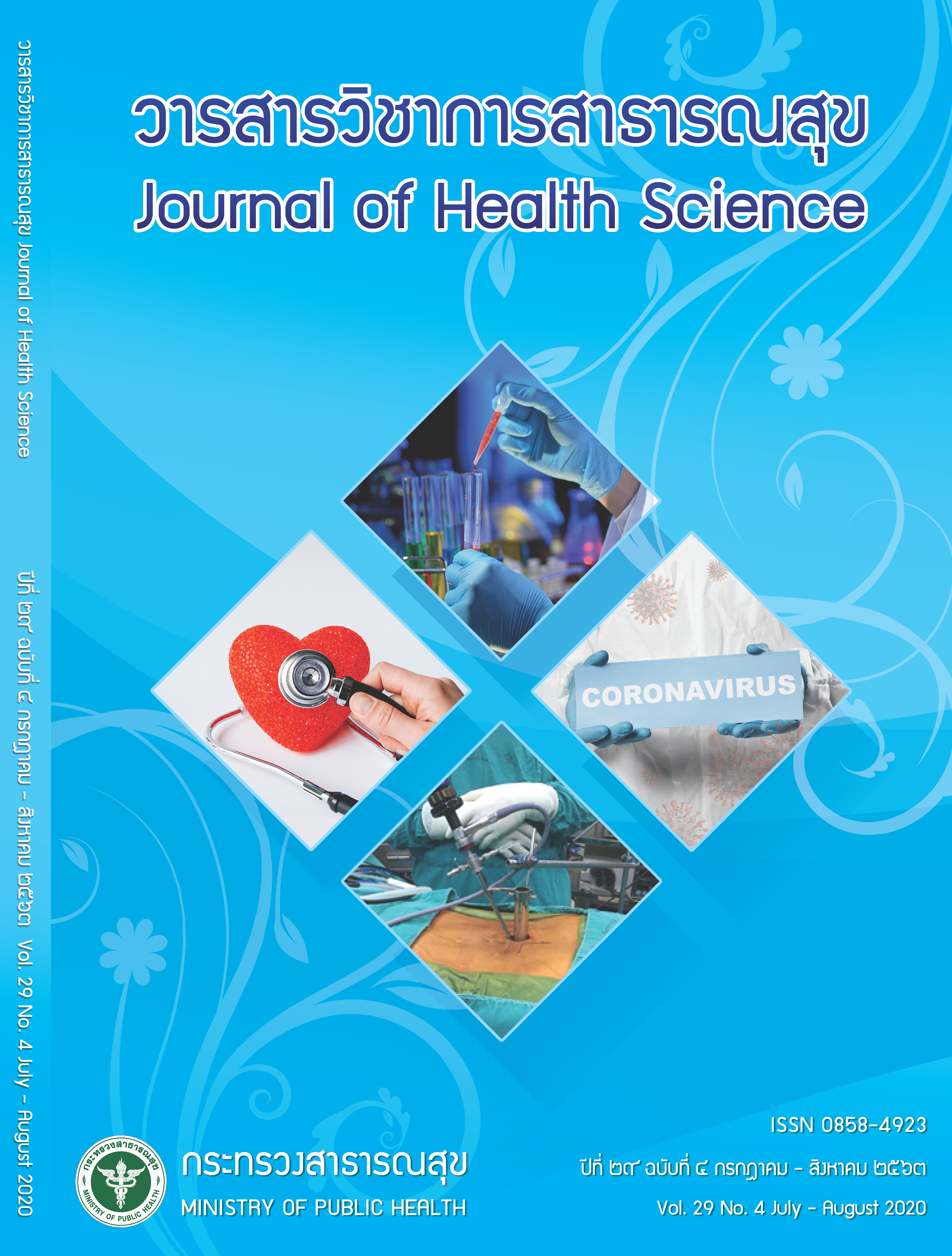Anti-Staphylococcus epidermidis Acnes by Bio-Cellulose Acne Patches from Mangosteen Peel Extracts
Keywords:
bio-cellulose acne patches, crude extracts from mangosteen peel, Staphylococcus epidermidisAbstract
Staphylococcus epidermidis is a major cause of inflammatory acne. Development of bio-cellulose acne patches from mangosteen peel extracts for inhibiting acne-causing bacteria. This research aimed to study the effectveness of crude extracts from mangosteen peel against S. epidermidis, and to develop acne patch from bio-cellulose with mangosteen peel extracts against S. epidermidis. In the process, mangosteen peels were extracted by 95% ethanol. The plant crude extracts were dissolved using dimethyl sulfoxide solution and preliminarily examined against bacteria using paper disc diffusion method and crude extracts of the plant were tested for the minimal inhibitory concentration (MIC) and minimal bactericidal concentration (MBC) using broth dilution test. The results showed that the crude extracts of the plant were found to inhibit the growth of the bacteria. The crude extracts from mangosteen peel inhibited S. epidermidis with MIC and MBC values of 51,200 µg/ ml. Thus, 51,200 µg/ml concentration of the crude extracts was applied to produce bio-cellulose acne patches from mangosteen peel extracts to inhibit S. epidermidis. The bio-cellulose acne patches were tested for inhibition effect against acne-causing bacteria using paper disc diffusion method. The results indicated that bio-cellulose acne patches from mangosteen peel extracts were effective in inhibiting the growth of bacteria.
Downloads
References
Pathek R. Staphylococcus epidermidis in human skin microbiome associated with acne: a cause of disease or defense. Research Journal of Biotechnology 2013; 8(12):78-82.
อภัย ราษฎรวิจิตร. ยาปฏิชีวนะ (antibiotics) [อินเทอร์เน็ต].กรุงเทพมหานคร: คณะเภสัชศาสตร์ มหาวิทยาลัยมหิดล;2556 [สืบค้นเมื่อ 17 พ.ค. 2561]. แหล่งข้อมูล: http://haamor.com/th
อัษฎาวุธ หิรัญรัตน์, ปรีญานันท์ วงศ์สวัสดิ์, วรรณฤดี หิรัญรัตน์, พนิตา สุมานะตระกูล. การศึกษาฤทธิ์ต้านออกซิเดชันของน้ำส้มควันไม้จากผลมังคุด. วารสารมหาวิทยาลัยทักษิณ 2556;16(3):120-30.
Pratiwi L, Fudholi A, Martien R, Pramono S. Develop-ment of TLC and HPTLC method for determinationα-mangostin in mangosteen peels (Garcinia mangostanaL.,). International Journal of Pharmacognosy and Phy-tochemical Research 2017;9(3):297-302
อุดมลักษณ์ สุขอัตตะ, อุไรวรรณ ดิลกคุณานันท์, ประภัสสร รักถาวร, สิริพร ศิริวรรณ, พจมาน พิศเพียงจันทร์. การสกัดและการออกฤทธิ์ยับยั้งเชื้อจุลินทรีย์ของสารสกัดจากเปลือกมังคุด. ใน: การประชุมทางวิชาการของมหาวิทยาลัยเกษตรศาสตร์ ครั้งที่ 44; วันที่ 30 มกราคม - 2 กุมภาพันธ์2549; สถาบันค้นคว้าและพัฒนาผลิตภัณฑ์อาหารมหาวิทยาลัยเกษตรศาสตร์, กรุงเทพมหานคร: 2549. หน้า 529-36.
Koh JJ, Qiu S, Zou H, Lakshminarayanan R, Li J, Zhou X, et al. Rapid bactericidal action of alpha- mangostin against MRSA as an outcome of membrane targeting. Biochimica et Biophysica Acta 2013;828(2):834-44.
Pothitirat W, Chomnawang MT, Gritsanapan W. Anti-acne-inducing bacterial activity of mangosteen fruit rind extracts. Medical Principles and Practice 2009; 19(4):281-6.
Wetchakun C, Puapermpoonsiri U, Sila-on W. Effect of alcohol and co-film former on the physical and mechan-ical properties. Isan J Pharm Sci 2016;3(11):25-31.
Saibuatong O, Phisalaphong M. Novo aloe vera–bacte-rial cellulose composite film from biosynthesis. Carbo-hydrate Polymers 2010;79(2):455–60.
Halib N, Amin MCIM, Ahmad I. Physicochemical prop-erties and characterizations of nata de coco from local food industries as a source of cellulose. Sains Malaysiana 2012;41(2):205-11.
นุศวดี พจนานุกิจ, สมใจ ขจรชีพพันธุ์งาม. เจลสมุนไพรสำหรับยับยั้งแบคทีเรียที่ทำให้เกิดสิว. วารสารวิทยาศาสตร์-ลาดกระบัง 2553;19(2):47-58.
Banjara RA, Jadhav SK, Bhoite SA. Antibacterial activ-ity of di-2-ethylaniline phosphate screened by paper disc diffusion method. Journal of Applied PharmaceuticalScience 2012,2(7):230-3.
Chomnawang MT, Surassmo S, Nukoolkarn VS, Grit-sanapan W. Antimicrobial effects of Thai medicinal plants against acne-inducing bacteria. Journal of Ethnopharma-cology 2005;101(1-3):330-3.
Koh JJ, Qiu S, Zou H, Lakshminarayanan R, Li J, Zhou X, et al. Rapid bactericidal action of alpha-mangostin against MRSA as an outcome of membrane targeting. Biochimica et Biophysica Acta 2013;828(2):834-44.
Supomo A, Apriliana A, Purnawati T, Risqi A. Formu-lation of antiacne cream dosage form containing mango-steen (Garcinia mangostana L.) pericarp ethanolic extract.Indonesian Journal of Pharmaceutical and Clinical Re-search 2018;1(1):37-44.
จุฬาลักษณ์ เขมาชีวะกุล. การผลิตแบคทีเรียเซลลูโลสสายพันธุ์ Acetobacter xylinumและการประยุกต์ใช้ในอุตสาหกรรม. การเกษตรราชภัฎ2559;15(2):25-33.
Downloads
Published
How to Cite
Issue
Section
License

This work is licensed under a Creative Commons Attribution-NonCommercial-NoDerivatives 4.0 International License.







